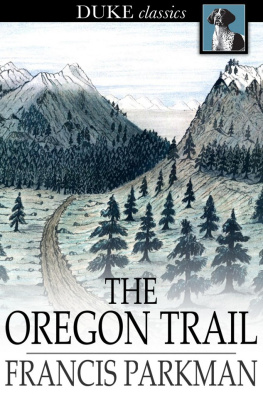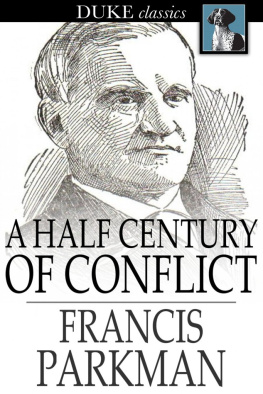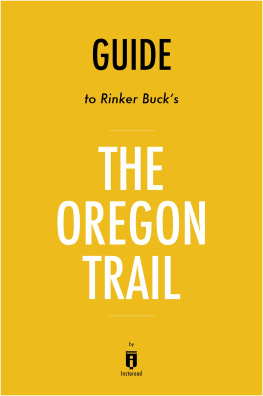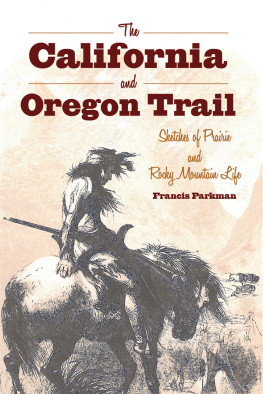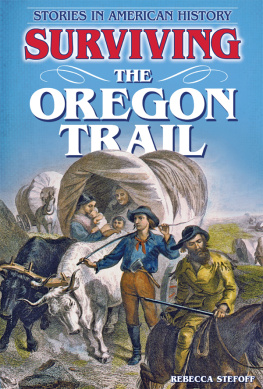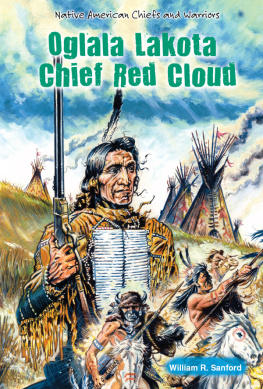THE OREGON TRAIL
SKETCHES OF PRAIRIE AND ROCKY MOUNTAIN LIFE
* * *
FRANCIS PARKMAN
*
The Oregon Trail
Sketches of Prairie and Rocky Mountain Life
First published in 1847
ISBN 978-1-62012-249-5
Duke Classics
2012 Duke Classics and its licensors. All rights reserved.
While every effort has been used to ensure the accuracy and reliability of the information contained in this edition, Duke Classics does not assume liability or responsibility for any errors or omissions in this book. Duke Classics does not accept responsibility for loss suffered as a result of reliance upon the accuracy or currency of information contained in this book.
Contents
*
Chapter I - The Frontier
*
Last spring, 1846, was a busy season in the City of St. Louis. Not onlywere emigrants from every part of the country preparing for the journeyto Oregon and California, but an unusual number of traders were makingready their wagons and outfits for Santa Fe. Many of the emigrants,especially of those bound for California, were persons of wealth andstanding. The hotels were crowded, and the gunsmiths and saddlerswere kept constantly at work in providing arms and equipments for thedifferent parties of travelers. Almost every day steamboats were leavingthe levee and passing up the Missouri, crowded with passengers on theirway to the frontier.
In one of these, the Radnor, since snagged and lost, my friend andrelative, Quincy A. Shaw, and myself, left St. Louis on the 28th ofApril, on a tour of curiosity and amusement to the Rocky Mountains. Theboat was loaded until the water broke alternately over her guards. Herupper deck was covered with large weapons of a peculiar form, forthe Santa Fe trade, and her hold was crammed with goods for the samedestination. There were also the equipments and provisions of a partyof Oregon emigrants, a band of mules and horses, piles of saddles andharness, and a multitude of nondescript articles, indispensable onthe prairies. Almost hidden in this medley one might have seen a smallFrench cart, of the sort very appropriately called a "mule-killer"beyond the frontiers, and not far distant a tent, together with amiscellaneous assortment of boxes and barrels. The whole equipage wasfar from prepossessing in its appearance; yet, such as it was, it wasdestined to a long and arduous journey, on which the persevering readerwill accompany it.
The passengers on board the Radnor corresponded with her freight. In hercabin were Santa Fe traders, gamblers, speculators, and adventurersof various descriptions, and her steerage was crowded with Oregonemigrants, "mountain men," negroes, and a party of Kansas Indians, whohad been on a visit to St. Louis.
Thus laden, the boat struggled upward for seven or eight days againstthe rapid current of the Missouri, grating upon snags, and hanging fortwo or three hours at a time upon sand-bars. We entered the mouth ofthe Missouri in a drizzling rain, but the weather soon became clear,and showed distinctly the broad and turbid river, with its eddies, itssand-bars, its ragged islands, and forest-covered shores. The Missouriis constantly changing its course; wearing away its banks on oneside, while it forms new ones on the other. Its channel is shiftingcontinually. Islands are formed, and then washed away; and while the oldforests on one side are undermined and swept off, a young growth springsup from the new soil upon the other. With all these changes, the wateris so charged with mud and sand that it is perfectly opaque, and ina few minutes deposits a sediment an inch thick in the bottom of atumbler. The river was now high; but when we descended in the autumnit was fallen very low, and all the secrets of its treacherous shallowswere exposed to view. It was frightful to see the dead and broken trees,thick-set as a military abatis, firmly imbedded in the sand, and allpointing down stream, ready to impale any unhappy steamboat that at highwater should pass over that dangerous ground.
In five or six days we began to see signs of the great western movementthat was then taking place. Parties of emigrants, with their tents andwagons, would be encamped on open spots near the bank, on their way tothe common rendezvous at Independence. On a rainy day, near sunset, wereached the landing of this place, which is situated some miles fromthe river, on the extreme frontier of Missouri. The scene wascharacteristic, for here were represented at one view the mostremarkable features of this wild and enterprising region. On the muddyshore stood some thirty or forty dark slavish-looking Spaniards, gazingstupidly out from beneath their broad hats. They were attached to one ofthe Santa Fe companies, whose wagons were crowded together on the banksabove. In the midst of these, crouching over a smoldering fire, was agroup of Indians, belonging to a remote Mexican tribe. One or two Frenchhunters from the mountains with their long hair and buckskin dresses,were looking at the boat; and seated on a log close at hand were threemen, with rifles lying across their knees. The foremost of these, atall, strong figure, with a clear blue eye and an open, intelligentface, might very well represent that race of restless and intrepidpioneers whose axes and rifles have opened a path from the Allegheniesto the western prairies. He was on his way to Oregon, probably a morecongenial field to him than any that now remained on this side the greatplains.
Early on the next morning we reached Kansas, about five hundredmiles from the mouth of the Missouri. Here we landed and leaving ourequipments in charge of my good friend Colonel Chick, whose log-housewas the substitute for a tavern, we set out in a wagon for Westport,where we hoped to procure mules and horses for the journey.
It was a remarkably fresh and beautiful May morning. The rich andluxuriant woods through which the miserable road conducted us werelighted by the bright sunshine and enlivened by a multitude of birds. Weovertook on the way our late fellow-travelers, the Kansas Indians, who,adorned with all their finery, were proceeding homeward at a round pace;and whatever they might have seemed on board the boat, they made a verystriking and picturesque feature in the forest landscape.
Westport was full of Indians, whose little shaggy ponies were tied bydozens along the houses and fences. Sacs and Foxes, with shaved headsand painted faces, Shawanoes and Delawares, fluttering in calico frocks,and turbans, Wyandottes dressed like white men, and a few wretchedKansas wrapped in old blankets, were strolling about the streets, orlounging in and out of the shops and houses.
As I stood at the door of the tavern, I saw a remarkable looking personcoming up the street. He had a ruddy face, garnished with the stumps ofa bristly red beard and mustache; on one side of his head was a roundcap with a knob at the top, such as Scottish laborers sometimes wear;his coat was of a nondescript form, and made of a gray Scotch plaid,with the fringes hanging all about it; he wore pantaloons of coarsehomespun, and hob-nailed shoes; and to complete his equipment, a littleblack pipe was stuck in one corner of his mouth. In this curious attire,I recognized Captain C. of the British army, who, with his brother, andMr. R., an English gentleman, was bound on a hunting expedition acrossthe continent. I had seen the captain and his companions at St. Louis.They had now been for some time at Westport, making preparations fortheir departure, and waiting for a re-enforcement, since they were toofew in number to attempt it alone. They might, it is true, have joinedsome of the parties of emigrants who were on the point of setting outfor Oregon and California; but they professed great disinclination tohave any connection with the "Kentucky fellows."

